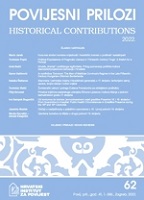Vjenčana kumstva na Mljetu u drugoj polovini 19. stoljeća
Wedding Witnesses on the Island of Mljet in the Second Half of the 19th Century
Author(s): Marija Gjurašić, Ahmet KalajdžićSubject(s): Cultural history, Ethnohistory, Cultural Anthropology / Ethnology, 19th Century
Published by: Hrvatski institut za povijest
Keywords: marriage; wedding witnesses; best man; maid of honour; kinship marriages; “test marriages”; island of Mljet; Babino Polje; Maranovići; 19th century;
Summary/Abstract: The paper investigates the intensity and rhythm of weddings in the parishes of Babino Polje (1870-1877) and Maranovići (1870-1884) on the island of Mljet. The authors have analysed the practice of choosing wedding witnesses, their number, gender structure and social status, the option of having multiple witnesses, and blood relations between the newlyweds and their wedding witnesses. Furthermore, the analysis includes kinship and widowhood marriages as well as “test marriages,” and sporadically also wedding customs on the island. Demographic and economic factors and emigration influenced the annual intensity of weddings, while the monthly rhythm reflected everyday life and was conditioned by seasonal work in agriculture, similar to the rest of Dalmatia. Wedding ceremonies in the parish of Babino Polje were mainly held on Sundays, and in the parish of Maranovići on Mondays. A strong horizontal link between the wedding witnesses and the bridal couple has been observed, which means that mostly they were all of the same social status. This is to be expected, because in a rural environment such as Mljet, where there are no cities, people live a rural life and the social differentiation of the population is very limited. Although social status is determined by a number of factors, in this paper it has been defined by occupation alone, given that the sources do not provide other data. Therefore, the results of this part of the research should be taken with some reserve, especially since persons of different social status may be hiding behind the same occupation. The offshore position of the island and the low rate of immigration narrowed down the choice of marital partners, which resulted in a large number of kinship marriages. Using the isonomy method, it has been determined that almost two fifths of the analysed marriages were concluded between relatives. Difficult living conditions in the 19th century, which marked the entire province, left their trace on Mljet as well, so every fifth bridegroom on the island was a widower. These were relatively young men who, due to the untimely death of their wives, were forced to look for a new life partner, partly because of the need to run a rural household and help them raise children, if they had any from their first marriage. Most likely in order to reduce the risk of infertility, but also to bring the couple closer together and especially to see if the girl was fitted the new family, the families organized “test marriages” that would often be formally legalized later on, usually only after the offspring was born.
Journal: Povijesni prilozi
- Issue Year: 2022
- Issue No: 62
- Page Range: 317-354
- Page Count: 40
- Language: Croatian

